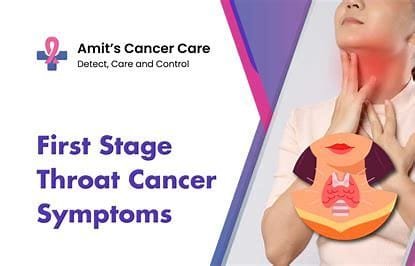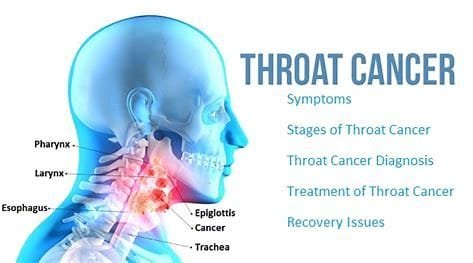Introduction

Throat cancer refers to cancer formed on the pharynx—the throat area, the voice box (larynx), or on the tonsils; it hampers fundamental capabilities such as breathing, speech, and swallowing. Often, two types are involved that include pharyngeal cancer (throat) and laryngeal cancer (voice box). If treated immediately, these cancers have far fewer chances of complicating themselves and, therefore, leading to the death of individuals.
The exact cause for throat cancer is not sometimes known, but certain causative factors that predispose one to develop the disorder include lifestyle choices, environmental exposure, and genetic predispositions.
Causes
Smoking and alcohol consumption: Tobacco use is one of the major risk factors for developing throat cancer. Smokers are at a much greater risk than nonsmokers because tobacco contains harmful chemicals that damage the cells lining the throat. Heavy and prolonged alcohol use increases the risk. Risk increases manifold if smoking combines with heavy alcohol consumption.
Human Papillomavirus (HPV): HPV is a sexually transmitted virus that causes abnormal cell growth in the throat. Some types, such as HPV-16, are linked to oropharyngeal cancer, which is a type of throat cancer involving the tonsils and the back of the throat. Over the last two decades, HPV-related throat cancer has been rising steadily, especially among younger adults.
Diet and nutritional deficiencies: Lack of fruit and vegetables in the diet may be one of the causative factors of throat cancer. Antioxidants, vitamins, and minerals in the plant-based food can offer protection to the cells, thus preventing cancerous damage. The chronic nutritional deficiencies, with a particular lack of vitamin A, have also been associated with throat cancer.
Genetics and Family History: There are genetic factors that predispose a person to the development of throat cancer. In this case, if one of the first-degree relatives has had throat cancer or other head and neck cancers, then the risk may be more pronounced.
Environmental Factors: Chronic exposure to chemicals such as asbestos, wood dust, and some industrial pollutants may cause irritation to the mucous membrane lining of the throat, which may trigger abnormal cell changes and increase the risk of developing throat cancer.
Disadvantages and Challenges of Throat Cancer
Throat cancer poses a range of physical, emotional, and social challenges that the disease and its treatments bring, and the symptoms it causes can be extremely incapacitating for a patient’s quality of life. The more one is aware of such challenges, the better placed they are to find ways of overcoming them.
Depending on the location of the cancer, patients will experience an altered quality to their voice, hoarseness, or completely losing their voice. Other treatments, like surgery or radiation, have permanent effects on the vocal cords, which impair speech irreversibly.
Difficulty Swallowing (Dysphagia): Pain or tightness may be caused by cancer or treatments that patients experience in the throat, due to which they have a very hard time swallowing. So, these patients suffer weight loss due to malnutrition and, in some instances, dehydration due to eating and drinking avoidance.
Breathing Problems: A tumor in the throat or larynx may compress the airway. Some patients may require a tracheostomy—a procedure in which a surgeon makes an opening in the neck to place a breathing tube, bypassing the airway obstruction.
Such psychological and emotional pressures might further damage the physical changes related to throat cancer in the psyche of the patient. He or she might become susceptible to undue stress, anxiety, or depression upon realizing that such changes also affected his or her personality.
Social Isolation: These are the apparent symptoms of throat cancer in addition to voice changes and communication difficulties. Patients will likely avoid social interactions; therefore, they need counseling or therapy to sustain social contacts.
Throat Cancer Treatment

Nowadays, the methods of treatment are highly advanced, so many lives have been saved, and appropriate therapy can be given according to the unique condition of the patient. Treatment also depends upon the stage of cancer, location, health condition, and the patient’s individual preference.
Surgery: For cancer that is only in the throat, surgery would just be the removal of the area of disease, leaving the rest of the healthy tissue intact. If the carcinoma is advanced or has extended into the surrounding tissues, part of the larynx or pharynx may have to be removed. In some cases, a total laryngectomy—removal of the entire voice box—will be necessary. Those individuals who have this done will also require therapy to learn different methods of speech.
Radiation Therapy: Radiation employs high-energy rays to destroy cancer cells. Radiation therapy is primarily used when the cancer is first diagnosed or as a follow-up treatment after surgery to ensure that all cancer cells are destroyed. In some cases, radiation can be used to shrink larger tumors before they are surgically removed, and these treatments can have side effects, including sore throat, dry mouth, and changes in the skin.
Chemotherapy: Chemotherapy employs drugs that can kill cancer cells or inhibit their growth. Chemotherapy is often administered in conjunction with radiation for advanced cases. The drawback of chemotherapy is that it can also have some severe side effects such as nausea, hair loss, fatigue, and weakened immune function.
Targeted Therapy: This is the use of drugs that selectively target the proteins of cancer cells so that their growth is terminated. For example, cetuximab is a type of targeted therapy drug to be applied to some forms of throat cancer. These drugs have fewer side effects than the traditional chemotherapy treatment but may not be taken by everyone.
Immunotherapy: Immunotherapy increases the immunity of the body towards the cancerous cells. In many cases, it acts when other treatments fail or the cancer is very aggressive. A lot of hopes have been built upon the immunotherapy drug pembrolizumab, which seems to be promising and can delay the progress of advanced throat cancer by killing cancerous cells and letting the immune system fight back.
Rehabilitation and Palliative Care: Rehabilitation has its utility stage for a patient suffering with throat cancer, mostly for the post-invasive phase of therapy. Speech as well as swallowing rehabilitation has been very helpful for retrieval from loss of communication capacity and recovery of ability of swallowing.
Emotional Healing through Counseling and Support Organizations: Counseling and support organizations can help an individual address the psychological effects of diseases and recovery.
Conclusion

Through cancer is really a dangerous health issue that has various causes. A few of them range through lifestyle determinants while on genetic fronts. While it is a serious disease, early detection and the advancement of treatment can increase the chances of recovery. A proactive approach, such as lifestyle changes that reduce risk factors and regular screenings among people at risk, can play a great role in prevention and early diagnosis. Medical support, rehabilitation, and emotional care can greatly benefit throat cancer patients in enhancing their recovery journey and improving quality of life.



